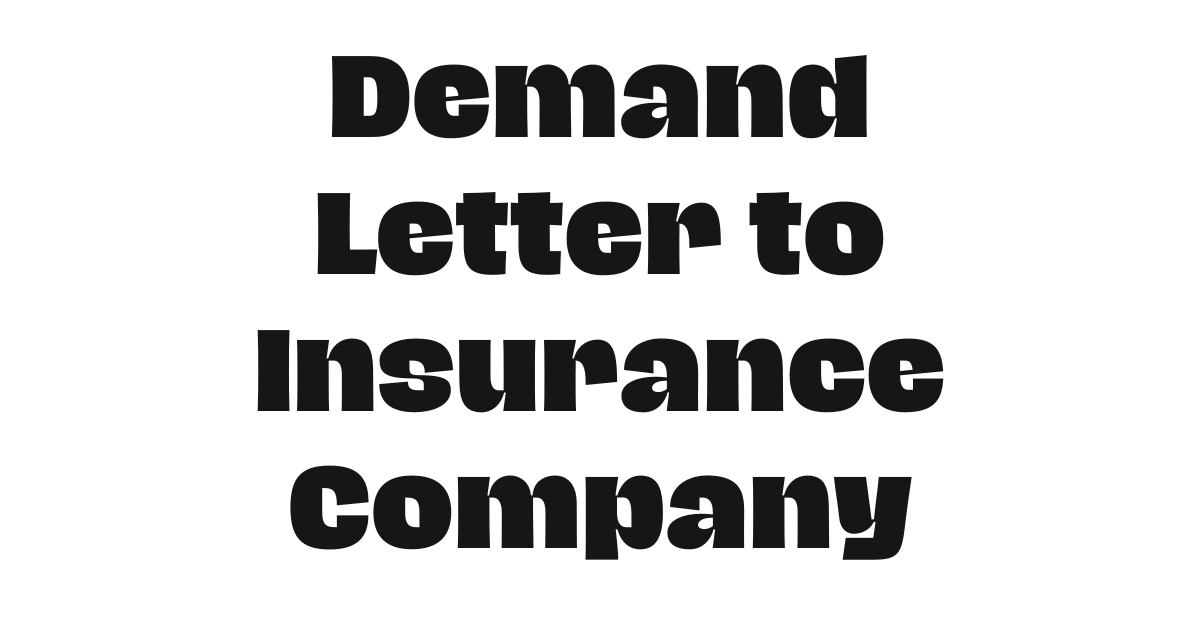In the realm of insurance claims and disputes, the demand letter stands as a potent tool, wielding the power to articulate your grievances and pursue rightful compensation. Let’s unravel the essence of the “demand letter to insurance company” and understand its crucial role.
A demand letter to an insurance company is a written communication that succinctly outlines your claim, details the damages or losses incurred, and articulates the compensation you seek. Its purpose is clear: to formally demand that the insurance company fulfill its obligations, whether it be for property damage, personal injury, or any other covered incident. Think of it as the initial step in a structured dialogue aimed at resolving your claim.
In this article, we embark on a journey to demystify the art of crafting impactful demand letters. We recognize that the process can be daunting, and that’s why we’re here to provide you with templates, examples, and samples of demand letters tailored for various situations. This resource aims to empower you with the right words, structure, and legal nuances, making it easier for you to navigate the complexities of drafting a compelling demand letter. Whether you’re dealing with a car accident, property damage, or personal injury, our collection of letter samples is designed to guide you through the letter-writing process with confidence.
As we delve into the intricacies of demand letters, our mission is to equip you with the knowledge and tools necessary to effectively communicate your claim, fostering a transparent and constructive dialogue with the insurance company. Let’s embark on this journey together, where the written word becomes a powerful advocate for your rights.

Sample of Demand Letter to Insurance Company
[Your Name]
[Your Address]
[City, State, ZIP Code]
[Email Address]
[Phone Number]
[Date]
[Insurance Company Name]
[Claims Department]
[Address]
[City, State, ZIP Code]
Subject: Formal Demand for Compensation
Dear [Insurance Company Name],
I trust this letter finds you well. I am writing to bring to your attention a matter regarding a recent incident covered under my insurance policy, and I am seeking fair compensation for the damages incurred. I believe in the importance of open communication, and I hope this letter serves as a constructive step toward resolving this matter amicably.
On [date], I experienced [describe the incident briefly], which resulted in [mention the damages or losses]. I promptly reported the incident to your claims department, and my claim was assigned under the reference number [claim number]. Despite my efforts to provide all necessary documentation and information promptly, there has been a delay in processing my claim.
I understand that investigations take time, but the prolonged delay is causing undue financial strain. I kindly request a thorough review of my case and a prompt resolution. I have attached all relevant documents, including [list any documents attached, such as photos, estimates, or medical reports], for your perusal.
I believe in the principles of fairness and responsibility that your esteemed company upholds. As a loyal policyholder for [duration], I trust that you will give due consideration to my claim. My aim is not to disrupt the relationship but to reach a fair and equitable settlement.
I look forward to your prompt attention to this matter and hope for a resolution within [reasonable timeframe, e.g., 30 days] from the date of this letter. Should you require any additional information, please do not hesitate to contact me at [your phone number] or [your email address].
Thank you for your understanding and cooperation.
Sincerely,
[Your Full Name]
[Your Signature – if sending a physical copy]
How to Write a Demand Letter to Insurance Company

1. Understanding the Purpose
When embarking on the task of writing a demand letter to your insurance company, clarity about its purpose is crucial. This initial step involves comprehending why you are writing the letter—whether it’s seeking compensation for damages, addressing claim delays, or requesting a review of your case. Clearly defining your objective lays the foundation for an effective and purposeful communication.
2. Gathering Necessary Information
Before putting pen to paper, ensure you have all pertinent information at your fingertips. This includes details of the incident, your insurance policy number, claim reference, and any supporting documents such as photographs, estimates, or medical reports. A meticulous collection of data not only strengthens your case but also demonstrates a proactive and informed approach to the insurance company.
3. Crafting a Compelling Introduction
The opening of your demand letter sets the tone for the entire communication. An engaging introduction succinctly outlines the incident, its repercussions, and expresses your expectation for a fair resolution. This section should capture the reader’s attention, prompting them to delve into the specifics of your case.
4. Presenting a Detailed Account
In this section, provide a comprehensive account of the incident. Offer a chronological narrative, emphasizing key details without unnecessary embellishments. Utilize clear and concise language to convey the circumstances, making it easy for the insurance company to understand the nature and extent of your claim.
5. Explicitly Stating Your Demand
Make your financial demand explicit and justified. Break down the components of your claim, providing itemized details of the losses incurred. This section requires a persuasive yet objective tone, clearly articulating why the compensation sought is reasonable and fair based on the circumstances.
6. Assertive Closing for Action
End the letter with a firm yet polite closing that communicates your expectation for a timely response. Reiterate your willingness to cooperate, express the hope for an amicable resolution, and set a reasonable timeframe for the insurance company to address your claim.
7. Professional Formatting and Review
The final step involves ensuring your letter is professionally formatted. Check for grammatical errors, clarity of language, and coherence in the overall structure. A well-organized, error-free letter enhances its credibility and increases the likelihood of a favorable response.
By following these seven steps, you can navigate the process of writing a demand letter to your insurance company with confidence and effectiveness.
FAQs about a Demand Letter to Insurance Company
When it comes to dealing with insurance matters, composing a demand letter can be a crucial step. Below, I address some frequently asked questions regarding the art of crafting a demand letter to an insurance company.
1. How do I start a demand letter to my insurance company?
Begin by clearly stating the purpose of the letter and providing a concise overview of the incident. A compelling introduction sets the tone for effective communication.
2. What information should be included in a demand letter?
Ensure you include essential details such as incident specifics, policy number, and supporting documents like estimates or medical reports. A comprehensive collection of information strengthens your case.
3. How do I make my financial demand in the letter?
Clearly and explicitly state the compensation you are seeking. Break down the components of your claim, justifying each aspect with relevant details to make your demand reasonable and fair.
4. Is there a specific format for a demand letter?
Yes, maintaining a professional format is crucial. Organize your letter with a clear structure, check for grammatical errors, and ensure coherence to enhance its credibility.
5. What should be my approach in the closing of the letter?
End with a firm yet polite closing. Reiterate your expectation for a timely response, express your willingness to cooperate, and set a reasonable timeframe for the insurance company to address your claim.
By addressing these common questions, you’ll be better equipped to navigate the process of writing a demand letter to your insurance company effectively.
RELATED:
Pricing Increase Letter to Customers
